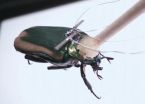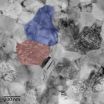(Press-News.org) The tiny two-spotted spider mite (Tetranychus urticae) causes much anxiety for farmers, and has been, to date, a scientific mystery. It feeds on over 1,100 species of plants, including 150 greenhouse plants and crops, such as maize, soy, tomatoes and citrus. The cost of chemically controlling damage caused by the spider mite exceeds USD 1 billion per year. In the latest issue of the journal Nature, a multinational consortium of scientists publish the sequenced genome of the spider mite, revealing how it is capable of such feeding frenzy, as well as other secrets of this tiny pest. These findings open the door to new approaches in pest control and crop protection, by allowing greater insight into the biological interactions between plants and herbivores that feed on them.
Élio Sucena and Sara Magalhães, group leaders at the Instituto Gulbenkian de Ciência (IGC) and the Centre for Environmental Biology, University of Lisbon (Portugal), respectively, are part of the 55-strong team of researchers from 10 countries that were involved in this project. Led by Miodrag Grbic (University of Western Ontario, Canada), this team analysed the genome of the spider mite, sequenced with funds from the US Department of Energy (DOE) Joint Genome Institute (JGI) programme, Genome Canada and the European Union.
The spider mite feeds on an astonishingly large number of plants because it withstands the toxins that plants produce. This in itself is an amazing feat. However, among arthropods (animals with exoskeletons, such as spiders, ticks, crustaceans and insects), the spider mite holds first place in the number of pesticides it is resistant to. Mites become resistant to new pesticides within two to four years, meaning that control of multi-resistant spider mites has become increasingly difficult.
Having the sequence of the spider mite genome has shown light on the genetic basis for its feeding flexibility and pesticide resistance. The secret lies in having, on the one hand, more copies of the genes involved in digesting and degrading plant toxins when compared to insects. On the other, the tiny pest seems to have incorporated genes from bacteria and fungi that are involved in digestion and detoxification.
Indeed, the researchers identified two groups of bacterial and fungi genes that are unique to the spider mite, suggesting that the tiny arthropod is adept at making the most of the innovation of transfer of genes between distant species (called lateral gene transfer - a rare occurrence in nature).
Other groups of genes are shared, with aphids, for example (aphids are insects that also feed on crops). By comparing the aphid genome with that of the spider mite, it seems that the bacterial genes moved first into the insects and from these were taken up by the spider mite.
The name gives it away: spider mites make webs, for protection against predators and as a barrier against bad weather. However, their webs are different to those made by spiders: the genome sequence has revealed 17 genes involved in making web proteins. These proteins make thinner fibres, but seem to be slightly more resistant to mechanical forces than other natural materials.
All these secrets came out of a very small genome - only 90 megabases (the fruit fly genome has 180 megabases; the human genome has 3,000 megabases). It is, indeed, the smallest arthropod genome sequenced so far, and reveals a remarkable evolutionary history: the spider mite has lost many genes that are shared amongst arthropods, but has accumulated species-specific genes, such as those that give it the ability to withstand toxins and pesticides.
The Portuguese scientists were involved in analysing immunity-related genes found in the spider mite genome. The spider mite belongs to the Chelicerata family, the second largest group of terrestrial animals. Chelicerates include spiders, scorpions and ticks. Chelicerates and insects make up the Arthropods. The spider mite is the first chelicerate to have its entire genome sequenced and analysed.
### END
Spider mite's secrets revealed
Tiny pest's genome opens door to novel approaches to crop protection and silk production
2011-11-24
ELSE PRESS RELEASES FROM THIS DATE:
Enhanced treatment of brain tumors
2011-11-24
Glioblastoma is regarded as the most malignant form of brain tumor. In many cases, neurosurgeons are not able to remove such tumors completely because of the risk of destroying too much brain tissue in the process. Moreover, it is often impossible to identify all the fine extensions by which the tumor spreads into surrounding healthy tissue. To at least slow down the growth of tumor cells that have remained in the head, almost all glioblastoma patients are treated by radiotherapy after surgery.
"Unfortunately, we can only delay cancerous growth in this way, but we cannot ...
Fault and Liability in California Slip and Fall Accidents
2011-11-24
Countless people sustain injuries each year while on the property of another person or business. Some of these injuries could have been prevented if the owner, manager or occupier of the property had taken basic safety precautions or behaved as a reasonable person would have in the same situation.
Every slip and fall or trip and fall accident does not automatically result in a personal injury claim, but some of them do. It takes a skilled personal injury attorney to know the difference between a frivolous case and one that is likely to succeed. Slip and fall, trip and ...
Closer to a cure for eczema
2011-11-24
Scientists have found that a strain of yeast implicated in inflammatory skin conditions, including eczema, can be killed by certain peptides and could potentially provide a new treatment for these debilitating skin conditions. This research is published today in the Society for Applied Microbiology's journal, Letters in Applied Microbiology.
20% of children in the UK suffer from atopic eczema and whilst this usually clears up in adolescence, 7% of adults will continue to suffer throughout their lifetime. Furthermore, this type of eczema, characterized by dry, itchy, flaking ...
Coming to terms with terror
2011-11-24
How will the terrorist attacks in Norway on 22 July change the country? That question has been put to three social scientists at the University of Stavanger (UiS).
"Norwegians are still in a state of shock," says professor Odd Einar Olsen. "These incidents were so extensive and gruesome that people need time to come to terms with them."
He is very interested to see what content Norway will give to promises made about more openness and democracy after the car-bombing in Oslo and the massacre at Utøya north of the capital.
"While people have united in sorrow, a crippling ...
Winter Weather Is Upon Us: How Drivers Can Stay Safe
2011-11-24
The long, cold Minnesota winters never fail to blanket the state's roadways, causing many weather-related accidents that can range from minor to severe. Minnesota was sixth in the nation for icy road fatalities during the 2009-2010 season, with 18 fatal accidents during that winter.
Minneapolis weather-related auto accident attorneys and other people who work with accident victims understand the danger that comes with winter driving. They encourage safe, cautious driving in the snow, ice and sleet.
Fortunately, there are several things drivers can do to stay safe ...
UMD poll: Egyptians see military putting brake on revolution 2:1
2011-11-24
COLLEGE PARK, Md. - A new University of Maryland public opinion poll finds Egyptians harboring serious doubts about their military's commitment to the revolution that ousted the Mubarak regime last spring.
In the poll, 43 percent of Egyptians said they believe military authorities are working against the aims of the revolution, compared to nearly 21 percent who saw them as advancing these aims.
"There appears to be a major shift in Egyptian public attitudes toward military authorities, and this will likely have important consequences for politics there in coming weeks," ...
Insect cyborgs may become first responders
2011-11-24
ANN ARBOR, Mich. -- Research conducted at the University of Michigan College of Engineering may lead to the use of insects to monitor hazardous situations before sending in humans.
Professor Khalil Najafi, the chair of electrical and computer engineering, and doctoral student Erkan Aktakka are finding ways to harvest energy from insects, and take the utility of the miniature cyborgs to the next level.
"Through energy scavenging, we could potentially power cameras, microphones and other sensors and communications equipment that an insect could carry aboard a tiny backpack," ...
New magnetic-field-sensitive alloy could find use in novel micromechanical devices
2011-11-24
Led by a group at the University of Maryland (UMd), a multi-institution team of researchers has combined modern materials research and an age-old metallurgy technique to produce an alloy that could be the basis for a new class of sensors and micromechanical devices controlled by magnetism.* The alloy, a combination of cobalt and iron, is notable, among other things, for not using rare-earth elements to achieve its properties. Materials scientists at the National Institute of Standards and Technology (NIST) contributed precision measurements of the alloy's structure and ...
Debt Collectors Battling State Regulations Aimed at Stopping Abuse
2011-11-24
According to the U.S. Federal Trade Commission (FTC), the number of consumer complaints against third-party debt collectors rose to 108,997 in 2010, up from about 90,000 in 2009. Federal Reserve data show that complaints rose even though consumer debt for the country overall fell to its lowest levels since 2005.
Debt collection companies have gotten more aggressive in their collection efforts in recent years. Complaints of creditor harassment have prompted many states to pass laws to regulate the industry more to prevent abuse.
In response, debt collection companies ...
Exercise helps us to eat a healthy diet
2011-11-24
A healthy diet and the right amount of exercise are key players in treating and preventing obesity but we still know little about the relationship both factors have with each other. A new study now reveals that an increase in physical activity is linked to an improvement in diet quality.
SINC
Many questions arise when trying to lose weight. Would it be better to start on a diet and then do exercise, or the other way around? And how much does one compensate the other?
"Understanding the interaction between exercise and a healthy diet could improve preventative and ...
LAST 30 PRESS RELEASES:
Diversifying US Midwest farming for stability and resilience
Emphasizing immigrants’ deservingness shifts attitudes
Japanese eels, climate change, and river temperature
Pusan National University researchers discover faster, smarter heat treatment for lightweight magnesium metals
China’s 2024 Gastroenterology Report: marked progress in endoscopy quality and disease management
Pusan National University researchers uncover scalable method for ultrahigh-resolution quantum dot displays
Researchers use robotics to find potential new antibiotic among hundreds of metal complexes
Gut bacteria changes at the earliest stages of inflammatory bowel disease
Scientists develop new way to “listen in” on the brain’s hidden language
Brain research: “Pulse generators” grow and shrink as memories are formed
For teens, any cannabis use may have impact on emotional health, academic performance
School meals could unlock major gains for human and planetary health
Menopause hormone therapy does not appear to impact dementia risk
Signature patterns of brain activity may help predict recovery from traumatic brain injury
Dresden study uncovers new key mechanism in cancer cells
New species are now being discovered faster than ever before, study suggests
Cannabis-based products show limited short-term benefit for chronic pain, with increased risk of adverse effects
Cannabis products with more THC slightly reduce pain but cause more side effects
Clearing the brain of aging cells could aid epilepsy and reduce seizures
Brain injuries linked with potential risk of suicide, new study finds
New technique lights up where drugs go in the body, cell by cell
New study finds movement of fishing fleets can reveal shifts in marine ecosystems
Embargoed: New evidence points to potential treatment for vascular dementia
Study uncovers disrupted brain balance in alcohol dependence
Working in groups can help Republicans and Democrats agree on controversial content moderation online
Structural findings reveal how distinct GPCR ligands create different levels of activation
Anything-goes “anyons” may be at the root of surprising quantum experiments
UC review: Maximizing workplace opportunity for veterans
From generation to complex control: Metasurfaces make perfect vortex beams "within reach"
Thin-film lithium niobate-based detector: recent advances and perspectives
[Press-News.org] Spider mite's secrets revealedTiny pest's genome opens door to novel approaches to crop protection and silk production


